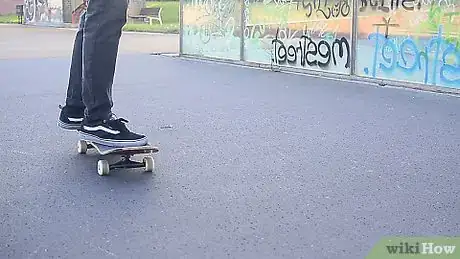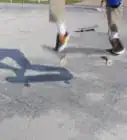This article was co-authored by Jon Depoian. Jon Depoian is a Skateboarding Instructor and the Owner of Intro2Skateboarding, an organization based in Orange County, California that provides professional private, home-school, after-school, birthday party, and summer camp skateboard lessons for beginners and experienced skateboarders alike. Jon has over 21 years of skateboarding experience and over 10 years of skateboard instruction experience. He also has extensive experience producing street skateboarding videos and skating competitions.
There are 11 references cited in this article, which can be found at the bottom of the page.
This article has been viewed 115,161 times.
When you’re first learning how to skateboard, it can be difficult to pick up new skills. You’ve gotten comfortable standing on the board, and can even push off and cruise a short distance in a straight line. Next, you’ll need to learn how to turn. Steering on a skateboard is done one of two ways: leaning your weight over one side of the board for gentle, sweeping turns, or lifting the tail and pivoting the nose for sharp, sudden changes of direction.
Things You Should Know
- You can turn via the leaning method or by using the tail to achieve a kick-turn.
- For the leaning method, ride with your feet over the board's bolts, lean forward or backward to turn your board, and finally, try to stay upright.
- To do a kick-turn, ride with your feet properly placed, move your back foot over the tail, push down just slightly, and finally, as the nose lifts up, use your front foot to guide your board in the right direction.
Steps
Leaning Into a Turn
-
1Push off and start riding. Place your front foot on the board just behind the nose and push off against the ground with your back foot. Give yourself three or four strong pushes to get moving at a decent speed. Set your back foot on the board. You should now be cruising along, aimed straight ahead.[1]
- It’s recommended that you get comfortable with the basics of skateboarding before attempting to learn how to turn.
- Strap up with the proper protective gear—a helmet, wrist guards and knee and elbow pads—to safeguard yourself against scrapes, bruises and more serious injuries.[2]
-
2Position your feet near the center of the board. Rest your lead foot right above the bolts that attach the board’s trucks to the deck. Slide your back foot forward until it’s in the same position over the rear trucks. This will ensure that you’re in the most stable position to keep your balance while turning.[3]
- Your feet should be lined up straight across the deck to create the leverage needed to generate the turn.
- Keep your feet away from the nose and tail. Putting too much weight on either edge will lift one set of wheels or the other off the ground.
Advertisement -
3Lean your weight in the direction you want to turn. Decide whether you want to steer to the left or to the right. If you ride regular (left foot up front), initiate a mild left turn by leaning your weight back over your heels, so that more pressure is put on the rear edge of the deck. Right turns can be performed by leaning over the toes.[4]
- The general idea is to simply lean in the direction you want to go. The fine-tuned mechanics of the skateboard will take care of the rest.
- These directions should be reversed for goofy riders (those who place their right foot up front).[5]
-
4Try to keep your balance. As the deck tilts, all your weight will be over the wheels on one side of the board. This will cause them to veer in the direction you’re leaning, resulting in a smooth, gradual turn. Bend your knees and lower your center of gravity slightly as you steer to keep from being forced off balance by the motion of the turn.
- If you find yourself falling off to the side of the board, you’re probably leaning too hard. Don’t be too heavy-footed. Try repositioning your weight delicately at first and working your way up to wider curves.
-
5Adjust your board to make turning easier. If you find that it’s difficult to perform leaning turns on your board, it may be because your trucks are too tight. Use a crescent or socket wrench to take a little tension out of the nut that secures and tightens the trucks. This will enhance their range and ease of motion, allowing you to glide into turns effortlessly.[6]
- Looser trucks will make leaning turns easier, but will reduce the overall stability of the board, as the deck will be able to move around more freely around the wheels.[7]
- Trucks are the metal axles that hold the wheels on, and there is one in the front and one in the back of the board.[8]
- Play around with different levels of tightness in the trucks to strike the right balance between stability and ease of movement.
Using the Tail to Kick-Turn
-
1Get moving. Push off and begin riding. Work up a little bit of speed before you approach your turn. Stay poised on the balls of your feet, ready to shift your weight.
- If you’re not moving fast enough when attempting a kick-turn, you’ll most likely just end up spinning in place over the rear wheels.
- You'd use a kick turn for a sharper turn or, for instance, to go up on a ramp, turn, then ride down the same way you came.[9]
-
2Place your feet in the proper position. As with the leaning method, keep your front foot rooted over the bolts of the front trucks. To perform a kick-turn, however, your back foot will need to be on the tail (the upturned rear edge of the board). Slide your rear foot back until it is in the center of the tail. You’re now in position to turn by lifting the front end of the board.[10]
- Keep your weight centered over the middle of the board. There’s no need to lean one way or the other as there is for an easier turn.
- Don’t put any weight on the tail until you’re actually ready to start turning. This is a good way to get acquainted with the concrete.
-
3Push down carefully on the tail. Using a slow, controlled motion, push down on the tail with your back foot and distribute your weight evenly between both feet momentarily. Pushing down on the tail while your center of balance is situated over the rear wheels will cause them to act like a teeter-totter, raising the nose of the board.[11]
- Pushing down too hard or too fast will force the tail into the ground, killing your speed, at best, or resulting in a nasty spill.
- Lifting the nose to steer will probably feel pretty foreign at first. Practicing the “manual”, a skill that involves balancing on the back wheels while rolling or stationary, may help you get a feel for negotiating your weight on the tail.[12]
-
4Redirect the nose to turn. From here, you can rotate the nose of the board in whichever direction you wish to turn. Guide the front end of the board with your lead foot and use a winding action of the shoulders and hips to swing the nose around. Using this technique will enable you to perform much sharper, more drastic turns, and will also come in handy for learning skills such as cornering, carving, etc.[13]
- These pivots will likely be smaller rotations, only a couple degrees, when you first start. It's called "tic tac toe."[14]
- Kick-turns can be used change the direction of the board up to about a 30 degree angle while moving. Any sharper than that and you’re likely to lose control.
- Be careful—the longer the front wheels stay off the ground, the greater the chance of the board flying out from under you.
-
5Return the front wheels to the ground. Once you’ve completed the turn, shift your weight to your lead foot to set the front wheels back down on the ground. Make sure to touch down with the front wheels nice and easy to avoid clumsily dropping the nose or throwing yourself off balance. Keep riding, pushing off to generate more speed. Congrats! You’re now fully mobile!
- Both methods of turning, leaning and kick-turns, are essential basic techniques to master when you’re learning how to skate.
Expert Q&A
Did you know you can get expert answers for this article?
Unlock expert answers by supporting wikiHow
-
QuestionHow do you turn on a skateboard?
 Jon DepoianJon Depoian is a Skateboarding Instructor and the Owner of Intro2Skateboarding, an organization based in Orange County, California that provides professional private, home-school, after-school, birthday party, and summer camp skateboard lessons for beginners and experienced skateboarders alike. Jon has over 21 years of skateboarding experience and over 10 years of skateboard instruction experience. He also has extensive experience producing street skateboarding videos and skating competitions.
Jon DepoianJon Depoian is a Skateboarding Instructor and the Owner of Intro2Skateboarding, an organization based in Orange County, California that provides professional private, home-school, after-school, birthday party, and summer camp skateboard lessons for beginners and experienced skateboarders alike. Jon has over 21 years of skateboarding experience and over 10 years of skateboard instruction experience. He also has extensive experience producing street skateboarding videos and skating competitions.
Skateboarding Instructor
-
QuestionCan I practice on a road?
 Elizabeth MilchefskiCommunity AnswerYes, but make sure it is an abandoned or not busy road. If you are just starting out in skating and don't know how to turn away from a car quickly, that could result in something pretty bad. So practice on a road with caution.
Elizabeth MilchefskiCommunity AnswerYes, but make sure it is an abandoned or not busy road. If you are just starting out in skating and don't know how to turn away from a car quickly, that could result in something pretty bad. So practice on a road with caution. -
QuestionDo I need wrist guards, or will elbow and knee pads suffice?
 Elizabeth MilchefskiCommunity AnswerElbow and knee pads should be sufficient, as long as you know how to fall on them.
Elizabeth MilchefskiCommunity AnswerElbow and knee pads should be sufficient, as long as you know how to fall on them.
Warnings
- You need to be moving with a fair amount of speed to be able to turn effectively, but don't go too fast. High speeds will make learning new techniques more complicated and potentially dangerous.⧼thumbs_response⧽
- Falls will inevitably happen, especially when you're first starting out. Make sure you're wearing a helmet, along with other protective gear like knee pads, elbow pads and wrist guards.⧼thumbs_response⧽
References
- ↑ https://sidewalkmag.com/skateboard-tricks/advice/skateboard-basics-sidewalk-basics.html
- ↑ http://skateboardsafety.org/
- ↑ http://www.skateboardhere.com/turning.html
- ↑ http://www.tactics.com/info/learning-to-skateboard
- ↑ https://www.skatexs.com/blogs/news/7494860-goofy-vs-regular-beginner-tips-for-kids-learning-to-skateboard
- ↑ https://www.skatexs.com/blogs/news/9432593-skateboard-maintenance-for-beginners
- ↑ http://www.skateboardhere.com/skateboard-trucks.html
- ↑ Jon Depoian. Skateboarding Instructor. Expert Interview. 5 June 2020.
- ↑ Jon Depoian. Skateboarding Instructor. Expert Interview. 5 June 2020.
- ↑ http://www.tactics.com/info/learning-to-skateboard
- ↑ http://www.skateboardhere.com/kickturn.html
- ↑ http://riders.co/en/skate/balance/manual/#
- ↑ https://www.youtube.com/watch?v=0xmdaovBNms
- ↑ Jon Depoian. Skateboarding Instructor. Expert Interview. 5 June 2020.
About This Article
It can take a lot of practice to learn how to turn on a skateboard, so make sure you always wear a helmet and wrist, knee, and elbow pads in case you fall. To practice, place your front foot on the board just behind the nose and push off against the ground with your back foot. Do this about 3 or 4 times before moving your back foot onto the board just above the wheels. While you’re moving, lean your body in the direction you want to turn. For instance, if you ride with your left foot up front, you would turn left by leaning backward slightly. Keep reading to learn how to do a kick-turn!




















-Step-17-Version-4.webp)





































